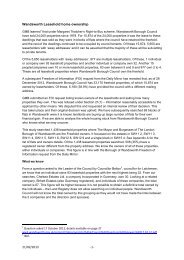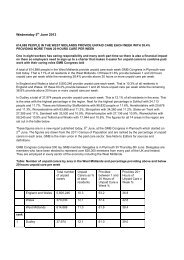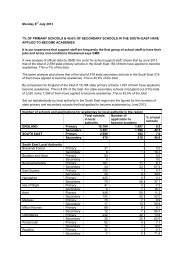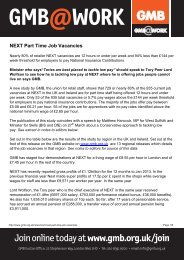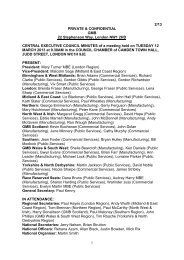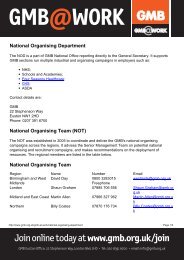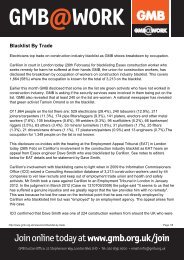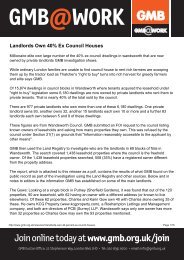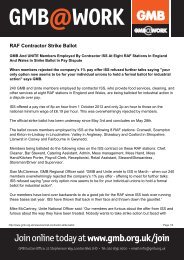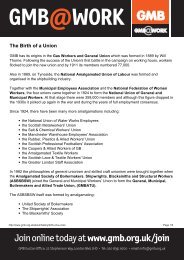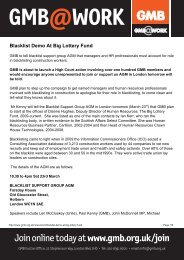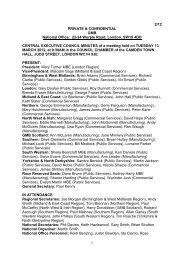WO toolkit 2012 complete.pdf - GMB
WO toolkit 2012 complete.pdf - GMB
WO toolkit 2012 complete.pdf - GMB
Create successful ePaper yourself
Turn your PDF publications into a flip-book with our unique Google optimized e-Paper software.
SECTION 17.2<br />
Discrimination–Indirect-formal&specific<br />
Occurs where on all racial grounds(but effectively grounds of colour or nationality)there is the use of<br />
an apparently non-discriminatory requirement or condition which applies equally to everyone but can<br />
only be met by a considerably smaller proportion of people form a particular racial group,is to the<br />
detriment of someone from that group and cannot be objectively justified.<br />
Discrimination–Institutional<br />
May be seen as the“collective failure of an organisation to provide an appropriate and professional<br />
service to people because of their colour,race,culture or ethnic origin.It can be seen or detected in<br />
processes,attitudes and behaviour which amount to discrimination through unwitting prejudice,<br />
ignorance,thoughtlessness and racist stereotyping which disadvantages minority ethnic people.”<br />
(Stephen Lawrence Inquiry Report 1999.)The“collective failure”can also result because of people’s<br />
gender,gender identity,sexual orientation,disability,religion or belief or age.<br />
Discrimination–Positive:<br />
Not the same as positive action.It involves treating someone from an equality target group more<br />
favourably than someone not in the group,regardless of whether they have the relevant skills and<br />
qualifications.It is illegal in the context of sex and race discrimination.<br />
Diversity<br />
Refers to the differences in the values,attitudes,cultural perspectives,beliefs,ethnic backgrounds,<br />
sexual orientation,skills,knowledge and life experiences of each individual in any group of people.This<br />
term refers to differences between people and is used to highlight individual need.Diversity includes<br />
visible and non-visible individual differences.They may include,but are not limited to,differences<br />
protected by anti-discrimination legislation.<br />
Equal Access<br />
Ensuring that no one receives less favourable treatment because of their ethnicity,colour,creed,<br />
national origin,gender,gender identity,marital status,class,disability or sexual orientation.Everyone<br />
has equal and full access to the services that are available.Offering flexible,responsive services in<br />
which differing needs are identified and accommodated so that each person benefits equally.<br />
Equalities<br />
Is used as a short hand term to refer to all work addressing issues of discrimination and disadvantage,<br />
particularly as it relates to race equality,disability,gender,gender identity,sexual orientation,religion<br />
or faith and age.<br />
Equality<br />
The vision or aim of creating a society(or aspects of society)where power and quality of life is shared<br />
equally and both individuals and groups are able to live their lives free from discrimination and<br />
oppression.It is a short-hand term for all work carried out by an organisation to promote equal<br />
opportunities and challenge discrimination in carrying out its work in employment and service<br />
delivery.<br />
Equality Impact Assessment<br />
Is a way of systematically assessing,recording and reporting on the likely impact of a strategy,policy or<br />
project on people from equality target groups.It involves anticipating and identifying potential<br />
equality consequences and ensuring that as far as possible any potential negative consequences are<br />
minimised or eliminated.It should be integral to the policy making process.



